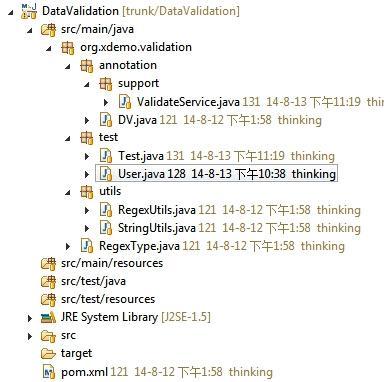本文转载自:https://www.jianshu.com/p/616924cd07e6
Java注解Annotation用起来很方便,也越来越流行,由于其简单、简练且易于使用等特点,很多开发工具都提供了注解功能,不好的地方就是代码入侵比较严重,所以使用的时候要有一定的选择性。
这篇文章将利用注解,来做一个Bean的数据校验。
下载
http://pan.baidu.com/s/1mgn2AHa
**项目结构 **
定义注解
该注解可以验证成员属性是否为空,长度,提供了几种常见的正则匹配,也可以使用自定义的正则去判断属性是否合法,同时可以为该成员提供描述信息。
定义注解
该注解可以验证成员属性是否为空,长度,提供了几种常见的正则匹配,也可以使用自定义的正则去判断属性是否合法,同时可以为该成员提供描述信息。
package org.xdemo.validation.annotation;
import java.lang.annotation.ElementType;
import java.lang.annotation.Retention;
import java.lang.annotation.RetentionPolicy;
import java.lang.annotation.Target;
import org.xdemo.validation.RegexType;
/**
* 数据验证
* @author Goofy
*/
@Retention(RetentionPolicy.RUNTIME)
@Target({ElementType.FIELD,ElementType.PARAMETER})
public @interface DV {
//是否可以为空
boolean nullable() default false;
//最大长度
int maxLength() default 0;
//最小长度
int minLength() default 0;
//提供几种常用的正则验证
RegexType regexType() default RegexType.NONE;
//自定义正则验证
String regexExpression() default "";
//参数或者字段描述,这样能够显示友好的异常信息
String description() default "";
}
注解的解析
package org.xdemo.validation.annotation.support;
import java.lang.reflect.Field;
import org.xdemo.validation.RegexType;
import org.xdemo.validation.annotation.DV;
import org.xdemo.validation.utils.RegexUtils;
import org.xdemo.validation.utils.StringUtils;
/**
* 注解解析
* @author Goofy
*/
public class ValidateService {
private static DV dv;
public ValidateService() {
super();
}
//解析的入口
public static void valid(Object object) throws Exception{
//获取object的类型
Class<? extends Object> clazz=object.getClass();
//获取该类型声明的成员
Field[] fields=clazz.getDeclaredFields();
//遍历属性
for(Field field:fields){
//对于private私有化的成员变量,通过setAccessible来修改器访问权限
field.setAccessible(true);
validate(field,object);
//重新设置会私有权限
field.setAccessible(false);
}
}
public static void validate(Field field,Object object) throws Exception{
String description;
Object value;
//获取对象的成员的注解信息
dv=field.getAnnotation(DV.class);
value=field.get(object);
if(dv==null)return;
description=dv.description().equals("")?field.getName():dv.description();
/*************注解解析工作开始******************/
if(!dv.nullable()){
if(value==null||StringUtils.isBlank(value.toString())){
throw new Exception(description+"不能为空");
}
}
if(value.toString().length()>dv.maxLength()&&dv.maxLength()!=0){
throw new Exception(description+"长度不能超过"+dv.maxLength());
}
if(value.toString().length()<dv.minLength()&&dv.minLength()!=0){
throw new Exception(description+"长度不能小于"+dv.minLength());
}
if(dv.regexType()!=RegexType.NONE){
switch (dv.regexType()) {
case NONE:
break;
case SPECIALCHAR:
if(RegexUtils.hasSpecialChar(value.toString())){
throw new Exception(description+"不能含有特殊字符");
}
break;
case CHINESE:
if(RegexUtils.isChinese2(value.toString())){
throw new Exception(description+"不能含有中文字符");
}
break;
case EMAIL:
if(!RegexUtils.isEmail(value.toString())){
throw new Exception(description+"地址格式不正确");
}
break;
case IP:
if(!RegexUtils.isIp(value.toString())){
throw new Exception(description+"地址格式不正确");
}
break;
case NUMBER:
if(!RegexUtils.isNumber(value.toString())){
throw new Exception(description+"不是数字");
}
break;
case PHONENUMBER:
if(!RegexUtils.isPhoneNumber(value.toString())){
throw new Exception(description+"不是数字");
}
break;
default:
break;
}
}
if(!dv.regexExpression().equals("")){
if(value.toString().matches(dv.regexExpression())){
throw new Exception(description+"格式不正确");
}
}
/*************注解解析工作结束******************/
}
}
用到的几个类
package org.xdemo.validation;
/**
* 常用的数据类型枚举
* @author Goofy
*
*/
public enum RegexType {
NONE,
SPECIALCHAR,
CHINESE,
EMAIL,
IP,
NUMBER,
PHONENUMBER;
}
其中正则验证类和字符串工具类请参考以下链接:
使用方法
package org.xdemo.validation.test;
import org.xdemo.validation.RegexType;
import org.xdemo.validation.annotation.DV;
public class User {
@DV(description="用户名",minLength=6,maxLength=32,nullable=false)
private String userName;
private String password;
@DV(description="邮件地址",nullable=false,regexType=RegexType.EMAIL)
private String email;
public User(){}
public User(String userName, String password, String email) {
super();
this.userName = userName;
this.password = password;
this.email = email;
}
public String getUserName() {
return userName;
}
public void setUserName(String userName) {
this.userName = userName;
}
public String getPassword() {
return password;
}
public void setPassword(String password) {
this.password = password;
}
public String getEmail() {
return email;
}
public void setEmail(String email) {
this.email = email;
}
}
测试代码
import org.xdemo.validation.annotation.support.ValidateService;
/**
* @author Goofy
*/
public class Test {
public static void main(String[] args){
User user=new User("张三", "xdemo.org", "252878950@qq.com");
try {
ValidateService.valid(user);
} catch (Exception e) {
e.printStackTrace();
}
user=new User("zhangsan","xdemo.org","xxx@");
try {
ValidateService.valid(user);
} catch (Exception e) {
e.printStackTrace();
}
user=new User("zhangsan","xdemo.org","");
try {
ValidateService.valid(user);
} catch (Exception e) {
e.printStackTrace();
}
}
}
运行效果

作者:会编程的小蚂蚁
链接:https://www.jianshu.com/p/616924cd07e6
來源:简书
简书著作权归作者所有,任何形式的转载都请联系作者获得授权并注明出处。
